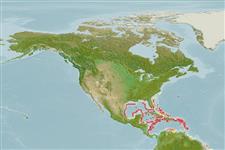Actinopterygii (ray-finned fishes) >
Perciformes (Perch-likes) >
Percophidae (Duckbills) > Bembropinae
Etymology: Bembrops: Greek, bembras, -ados = a kind of anchovy m+ Greek, ops = appearance (Ref. 45335); magnisquamis: Specific name from the Latin 'magnus' meaning large and 'squama' meaning scale.. More on author: Ginsburg.
Environment / Climate / Range
Ecology
Marine; bathydemersal; depth range 350 - 465 m (Ref. 13203). Deep-water, preferred ?
Western Central Pacific: Caribbean Sea.
Size / Weight / Age
Maturity: Lm ? range ? - ? cm
Max length : 10.5 cm SL male/unsexed; (Ref. 13203)
Short description
Morphology | Morphometrics
Dorsal
spines
(total): 6;
Dorsal
soft rays
(total): 15-16;
Anal
soft rays: 17. Color in alcohol uniformly light yellowish brown. Snout relatively short, almost equal to eye diameter, with scales on lateral and dorsal surfaces including the area in front of eye. Upper jaw extending behind anterior margin of eye. Maxillary tentacle long, tapering at the end. Lateral line descending gradually in region of pectoral fin, separated from origin of first dorsal fin by 2-4 rows of scales, from origin of anal fin by 4-5, and from insertion of anal fin by 2. Spines of first dorsal fin not elongated (Ref 13203).
Life cycle and mating behavior
Maturity | Reproduction | Spawning | Eggs | Fecundity | Larvae
Das, M.K. and J.S. Nelson, 1996. Revision of the percophid genus Bembrops (Actinopterygii: Perciformes). Bull. Mar. Sci. 59(1):9-44. (Ref. 13203)
IUCN Red List Status (Ref. 115185)
CITES (Ref. 94142)
Not Evaluated
Threat to humans
Harmless
Human uses
More information
Common namesSynonymsMetabolismPredatorsEcotoxicologyReproductionMaturitySpawningFecundityEggsEgg development
Age/SizeGrowthLength-weightLength-lengthLength-frequenciesMorphometricsMorphologyLarvaeLarval dynamicsRecruitmentAbundance
ReferencesAquacultureAquaculture profileStrainsGeneticsAllele frequenciesHeritabilityDiseasesProcessingMass conversion
Tools
Special reports
Download XML
Internet sources
Estimates of some properties based on models
Phylogenetic diversity index (Ref.
82805): PD
50 = 0.5000 [Uniqueness, from 0.5 = low to 2.0 = high].
Bayesian length-weight: a=0.00389 (0.00160 - 0.00946), b=3.08 (2.87 - 3.29), in cm Total Length, based on LWR estimates for this (Sub)family-body shape (Ref.
93245).
Trophic Level (Ref.
69278): 3.8 ±0.4 se; Based on size and trophs of closest relatives
Resilience (Ref.
69278): High, minimum population doubling time less than 15 months (Preliminary K or Fecundity.).
Vulnerability (Ref.
59153): Low vulnerability (20 of 100) .
